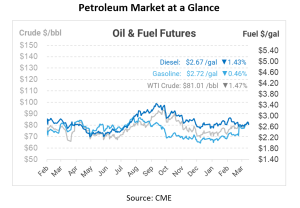
IEA Forecasts Mixed Outlook for Oil Demand and Supply
In a recent report, the International Energy Agency (IEA) presented a mixed picture of the global oil market, raising its forecast for oil-demand growth while simultaneously cutting estimates for global supply. The changes come against a backdrop of evolving economic conditions, geopolitical tensions, and ongoing shifts in energy consumption patterns.
According to the IEA, global oil demand growth is projected to reach 1.3 million barrels per day (b/d) for the year, up from a previous forecast of 1.2 million b/d. This revision stems from improved prospects in the U.S. market and increased bunker fuel consumption, partially driven by disruptions in trade flows due to recent Houthi attacks on Red Sea shipping. Despite this upward adjustment, the agency emphasized that demand growth is expected to decelerate significantly compared to the previous year, aligning more closely with historical trends.
Key drivers behind the increased demand include surging ethane demand in the US petrochemical sector and rising bunker fuel usage. However, the IEA also highlighted factors tempering oil consumption, such as a weaker economic outlook, efficiency improvements, and the growing popularity of electric vehicles.
While the IEA’s demand forecast shows a modest increase, its outlook for global supply has been revised downward. The agency now expects an average supply of 102.9 million b/d, down from the previous estimate of 103.8 million b/d. This adjustment primarily reflects lower output expectations from OPEC+, with the group deciding to extend voluntary production cuts until June. As a result, the global oil market is poised to shift from a surplus to a slight deficit for the year.
The disparity between the IEA’s projections and those of OPEC persists, with OPEC maintaining a more bullish stance on oil-demand growth. OPEC forecasts global demand growth of 2.2 million b/d for the current year, significantly higher than the IEA’s projection.
Looking at regional dynamics, the IEA anticipates the United States to continue leading global supply growth for the fourth consecutive year, driven by robust production in the country’s shale fields. Conversely, Saudi Arabia may see the world’s largest decline in production for a second consecutive year if it continues to shoulder the bulk of OPEC+ reductions.
Non-OPEC+ production, particularly in the US and Canada, is expected to rebound following weather-related constraints. However, the pace of growth is projected to be slower than in previous years, reflecting both operational challenges and broader market dynamics.

This article is part of Uncategorized
Tagged:
MARKET CONDITION REPORT - DISCLAIMER
The information contained herein is derived from sources believed to be reliable; however, this information is not guaranteed as to its accuracy or completeness. Furthermore, no responsibility is assumed for use of this material and no express or implied warranties or guarantees are made. This material and any view or comment expressed herein are provided for informational purposes only and should not be construed in any way as an inducement or recommendation to buy or sell products, commodity futures or options contracts.





